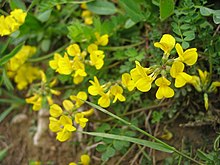Common horseshoe clover
| Common horseshoe clover | ||||||||||||
|---|---|---|---|---|---|---|---|---|---|---|---|---|

Common horseshoe clover ( Hippocrepis comosa ) |
||||||||||||
| Systematics | ||||||||||||
|
||||||||||||
| Scientific name | ||||||||||||
| Hippocrepis comosa | ||||||||||||
| L. |
The ordinary horseshoe Klee ( Hippocrepis comosa ), also Schopfiger horseshoe clover or simply horseshoe Klee called, is a plant from the genus Hippocrepis in the subfamily of Schmetterlingsblütler (Faboideae) within the family of the Leguminosae (Fabaceae).
description
The horseshoe clover is a perennial , herbaceous plant that reaches a height of 8 to 25 centimeters. It has numerous, branched, prostrate to ascending stems, often somewhat woody at the base . The shoots are 5 to 30 cm long. Plants with lignified shoots at the bottom are also considered a special variety, Hippocrepis comosa var. Alpina Rouy .
The imparipinnate leaves consist of four to eight, more rarely only three pairs of leaflets . The stipules are not fused together (only briefly with the leaf stem) and are much smaller than a leaflet.
The umbellate inflorescences are five to twelve flowers . The nodding yellow flowers are 7 to 12 mm long and fragrant; they are often provided with brownish veins, which serve as color marks for insects . The calyx teeth are triangular, the upper ones clearly longer than the lower ones. Nodding or protruding legumes are formed, which are flat with horseshoe-shaped limbs.
Flowering time is May (or April to September depending on the location).
The species has chromosome number 2n = 14 or 28.
ecology
The common horseshoe clover is an evergreen hemicryptophyte or woody chamaephyte. It has roots up to 60 centimeters deep.
Although it appears that the pollinators can access the nectar through a side flower slot, this is prevented by a plate covering the nectar. As a result, the proboscis of the visitors - bumblebees, bees and butterflies - can only be introduced past the stigma and the anthers and thus ensure pollination. Bumblebees can cause blossoms to collapse.
Flowering time is May (or April to September depending on the location).
The broken fruits disintegrate into 4–6 partial fruits when ripe. In the end, these are horseshoe-shaped, weigh around 4 mg and each contain a sickle-shaped seed. This is subject to intestinal expansion by goats and chamois, and it also spreads as a watery species and as a wing flyer.
The fruit ripens from August.
Occurrence
This species is common in southern and central Europe including the Alps . In Austria , the horseshoe clover is common in all federal states except Burgenland and Vienna . Its existence is endangered in the northern foothills of the Alps.
The common horseshoe clover can be found quite frequently and socially in sunny, limestone grasslands, on poor pastures, on paths and embankments, on cracks in the earth, and in quarries, also in sparse dry pine forests.
In the Allgäu Alps, near the Hermann-von-Barth-Hütte in Tyrol , it rises to 2030 m above sea level.
According to Heinz Ellenberg , it is a half-light plant, a moderate heat pointer, widespread oceanically, a dry pointer, a weak acid to weak base pointer and a type of association of sub-oceanic dry and semi-arid grasslands (Brometalia erecti). But it also occurs in societies of the order Festucetalia valesiacae in subalpine societies of the order Seslerietalia or in those of the Erico-Pinion association.
Others
The habitus of the vaginal vetch ( Coronilla vaginalis ) is similar, but in which the stipules grow together and together are about the size of a leaf. The bush vetch ( Hippocrepis emerus ) is another species of the genus.
The common horseshoe clover is a good fodder plant that is particularly popular with sheep. However, it is not cultivated. Since this species is widespread, the IUCN classifies this species as ( Least Concern ) at low risk.
literature
- Xaver Finkenzeller: Alpenblumen , Munich 2003, ISBN 3-576-11482-3
- Wolfgang Adler, Karl Oswald, Raimund Fischer: Excursion flora of Austria. Ed .: Manfred A. Fischer . Ulmer, Stuttgart / Vienna 1994, ISBN 3-8001-3461-6 .
- Erich Oberdorfer : Plant-sociological excursion flora for Germany and neighboring areas . 8th edition, Ulmer-Verlag, 2001, ISBN 3-8001-3131-5
- Heinz Ellenberg : Vegetation of Central Europe with the Alps from an ecological, dynamic and historical perspective. 5th, heavily changed and improved edition. Ulmer, Stuttgart 1996, ISBN 3-8001-2696-6 .
- Schmeil-Fitschen, interactive, Quelle & Meyer-Verlag, ISBN 3-494-01368-3
- Ruprecht Düll , Herfried Kutzelnigg : Pocket dictionary of plants in Germany and neighboring countries. The most common Central European species in portrait. 7th, corrected and enlarged edition. Quelle & Meyer, Wiebelsheim 2011, ISBN 978-3-494-01424-1 .
Individual evidence
- ↑ a b c Erich Oberdorfer : Plant-sociological excursion flora for Germany and neighboring areas . 8th edition. Stuttgart, Verlag Eugen Ulmer, 2001. Page 606. ISBN 3-8001-3131-5
- ↑ Erhard Dörr, Wolfgang Lippert : Flora of the Allgäu and its surroundings. Volume 2, IHW, Eching 2004, ISBN 3-930167-61-1 , p. 147.
- ↑ Hippocrepis comosa in the IUCN Red List of Threatened Species 2013.2. Posted by: Contu, S., 2010. Retrieved May 14, 2014.
Web links
- Common horseshoe clover. In: FloraWeb.de.
- Common horseshoe clover . In: BiolFlor, the database of biological-ecological characteristics of the flora of Germany.
- Profile and distribution map for Bavaria . In: Botanical Information Hub of Bavaria .
- Hippocrepis comosa L. In: Info Flora , the national data and information center for Swiss flora . Retrieved November 21, 2015.
- Thomas Meyer: Data sheet with identification key and photos at Flora-de: Flora von Deutschland (old name of the website: Flowers in Swabia )
- Pictures: [1]


